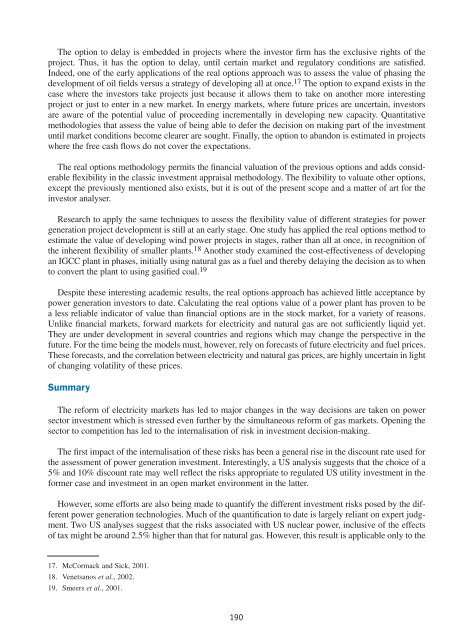Projected Costs of Generating Electricity - OECD Nuclear Energy ...
Projected Costs of Generating Electricity - OECD Nuclear Energy ...
Projected Costs of Generating Electricity - OECD Nuclear Energy ...
Create successful ePaper yourself
Turn your PDF publications into a flip-book with our unique Google optimized e-Paper software.
The option to delay is embedded in projects where the investor firm has the exclusive rights <strong>of</strong> the<br />
project. Thus, it has the option to delay, until certain market and regulatory conditions are satisfied.<br />
Indeed, one <strong>of</strong> the early applications <strong>of</strong> the real options approach was to assess the value <strong>of</strong> phasing the<br />
development <strong>of</strong> oil fields versus a strategy <strong>of</strong> developing all at once. 17 The option to expand exists in the<br />
case where the investors take projects just because it allows them to take on another more interesting<br />
project or just to enter in a new market. In energy markets, where future prices are uncertain, investors<br />
are aware <strong>of</strong> the potential value <strong>of</strong> proceeding incrementally in developing new capacity. Quantitative<br />
methodologies that assess the value <strong>of</strong> being able to defer the decision on making part <strong>of</strong> the investment<br />
until market conditions become clearer are sought. Finally, the option to abandon is estimated in projects<br />
where the free cash flows do not cover the expectations.<br />
The real options methodology permits the financial valuation <strong>of</strong> the previous options and adds considerable<br />
flexibility in the classic investment appraisal methodology. The flexibility to valuate other options,<br />
except the previously mentioned also exists, but it is out <strong>of</strong> the present scope and a matter <strong>of</strong> art for the<br />
investor analyser.<br />
Research to apply the same techniques to assess the flexibility value <strong>of</strong> different strategies for power<br />
generation project development is still at an early stage. One study has applied the real options method to<br />
estimate the value <strong>of</strong> developing wind power projects in stages, rather than all at once, in recognition <strong>of</strong><br />
the inherent flexibility <strong>of</strong> smaller plants. 18 Another study examined the cost-effectiveness <strong>of</strong> developing<br />
an IGCC plant in phases, initially using natural gas as a fuel and thereby delaying the decision as to when<br />
to convert the plant to using gasified coal. 19<br />
Despite these interesting academic results, the real options approach has achieved little acceptance by<br />
power generation investors to date. Calculating the real options value <strong>of</strong> a power plant has proven to be<br />
a less reliable indicator <strong>of</strong> value than financial options are in the stock market, for a variety <strong>of</strong> reasons.<br />
Unlike financial markets, forward markets for electricity and natural gas are not sufficiently liquid yet.<br />
They are under development in several countries and regions which may change the perspective in the<br />
future. For the time being the models must, however, rely on forecasts <strong>of</strong> future electricity and fuel prices.<br />
These forecasts, and the correlation between electricity and natural gas prices, are highly uncertain in light<br />
<strong>of</strong> changing volatility <strong>of</strong> these prices.<br />
Summary<br />
The reform <strong>of</strong> electricity markets has led to major changes in the way decisions are taken on power<br />
sector investment which is stressed even further by the simultaneous reform <strong>of</strong> gas markets. Opening the<br />
sector to competition has led to the internalisation <strong>of</strong> risk in investment decision-making.<br />
The first impact <strong>of</strong> the internalisation <strong>of</strong> these risks has been a general rise in the discount rate used for<br />
the assessment <strong>of</strong> power generation investment. Interestingly, a US analysis suggests that the choice <strong>of</strong> a<br />
5% and 10% discount rate may well reflect the risks appropriate to regulated US utility investment in the<br />
former case and investment in an open market environment in the latter.<br />
However, some efforts are also being made to quantify the different investment risks posed by the different<br />
power generation technologies. Much <strong>of</strong> the quantification to date is largely reliant on expert judgment.<br />
Two US analyses suggest that the risks associated with US nuclear power, inclusive <strong>of</strong> the effects<br />
<strong>of</strong> tax might be around 2.5% higher than that for natural gas. However, this result is applicable only to the<br />
17. McCormack and Sick, 2001.<br />
18. Venetsanos et al., 2002.<br />
19. Smeers et al., 2001.<br />
190

















